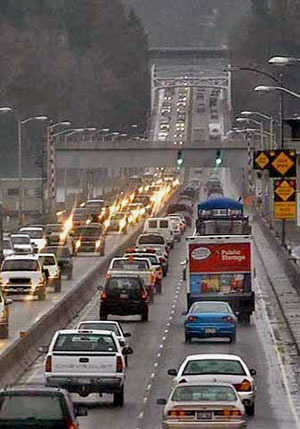Slow But Steady "Telework Revolution" Eyed 9/26/07
Matt Rosenberg
The nation and major urban regions within the West Coast Corridor of Cascadia and California - namely Vancouver, Seattle, Portland, Los Angeles, San Francisco and San Diego - continue to grapple with costly road and transit projects and the threat of global warming. These stem in part from workforce and population increases. Against this backdrop, common-sense trip reduction strategies such as telecommuting deserve more attention. Adopted on a broader scale, increased telecommuting can: help control road congestion and future transportation infrastructure costs; and help limit man-made greenhouse gas emissions and vehicle-related air pollution.
A recently-released study by Tiax LLC of Cambridge, Mass. for the Consumer Electronics Association calculates that telecommuting - or to use a much better phrase, telework - saves 840 million gallons of gas in the U.S. annually and reduces carbon dioxide emissions by 14 million metric tons. But media reports and the study itself may actually underestimate both the number of current U.S. teleworkers (those who work from home or remote work centers at least eight hours a week) and their cumulative environmental benefit. Reports on the TIAX study by, for instance, the San Jose Mercury News and a Washington Post blogger assert that the study finds there are 3.9 million U.S. workers who telecommute (at least once a week). But the TIAX study itself casts the numbers in a clearer light. First, (p. 39, link above), the study's actual stated estimate of U.S. workers who telecommute at least once a week is 4 to 6 million, not 3.9 million. That's because (p. 40, link above) the U.S. Energy Information Administration 2001 estimate used as the source is not of 3.9 million once-a-week telecommuters, but rather translates, as Tiax notes, to 3.9 million households where at least one member telecommutes at least once a week.
Not mentioned anywhere in the recent media reports on the Tiax study is that the EIA data cited is from a six-year-old survey, and that using the same definition of what constitutes telework, other more recent estimates size the current U.S. teleworker pool as two to three times that in the Tiax study. April 2007 information from Gartner Dataquest highlighted earlier this month in an in-depth MSNBC.com story on telework is that currently, 12 million U.S. employees work from home at least eight hours per week; up from 6 million in 2000; and growing to 14 million by 2009. Percentage-wise that's still a drop in the bucket, but some assert that the trend grow. Rita Walston of The Telework Consortium tells MSNBC we should expect to see four-fifths of larger corporate workforces working out-of-office in the future, either from home or remote work centers. The MSNBC story also notes that 56 percent of Sun Microsystems' employees use home or remote work centers, resulting in information technology and real estate savings to the company of $387 million per year.
The amount of telework per worker per week is a key variable not fully addressed in the current discussion. If one day of telework out of five is feasible, why not two or three or more? To an extent it still depends on the employee and work team, and the product or service. But face it: for all the considerable upside of working on-site, there are also downsides. Put another way, there's a reason Dilbert rules.
Obvious barriers to telecommuting are lack of trust from employers, and personal disconnectedness for teleworkers perhaps coupled in some instances with legitimate fears their career advancement will be harmed by lack of time spent on in-person alliance-building and office politicking. The reality is that even for teleworkers, there are times when there is simply no substitute for being on-site. Remote work centers can often serve this purpose in larger organizations, but for smaller or mid-sized workplaces, flexible on-site work spaces for teleworkers can be important.
Government programs including financial incentives for employers and employees to increase their use of telework and other trip reduction methods such as carpooling are one approach currently in vogue. But if telework is to reach a more critical mass in coming decades, it will be more due to corporate and political leaders who connect the dots between telework, employee retention, the daunting costs of transportation infrastructure upgrades, and man-made greenhouse gas emissions.
The phrase,'Unsound Transit', was coined by the Wall Street Journal to describe Seattle where,"Light Rail Madness eats billions that could otherwise be devoted to truly efficient transportation technologies." The Puget Sound's traffic congestion is a growing cancer on the region's prosperity. This website, captures news and expert opinion about ways to address the crisis. This is not a blog, but a knowledge base, which collects the best articles and presents them in a searchable format. My goal is to arm residents with knowledge so they can champion fact-based, rather than emotional, solutions.
Transportation
Monday, March 10, 2008
Slow Growth in Telecommuting
The articles are posted solely for educational purposes to raise awareness of transportation issues. I claim no authorship, nor do I profit from this website. Where known, all original authors and/or source publisher have been noted in the post. As this is a knowledge base, rather than a blog, I have reproduced the articles in full to allow for complete reader understanding and allow for comprehensive text searching...see custom google search engine at the top of the page. If you have concerns about the inclusion of a specific article, please email bbdc1@live.com. for a speedy resolution.









